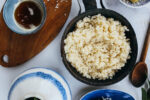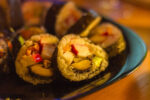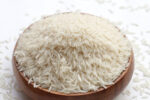Wild rice is an aquatic grass species native to North America, with seeds that resemble traditional rice but are not technically related. It grows naturally in freshwater lakes, rivers, and streams in regions such as the Great Lakes area in the United States and Canada. Wild rice is distinct from other rice varieties due to its earthy flavor, chewy texture, and dark color. It has gained popularity as a nutrient-dense alternative to conventional white or brown rice.
Characteristics of Wild Rice
Wild rice differs significantly from other rice varieties in both its appearance and flavor:
- Color: The grains are long, slender, and dark brown to black in color, giving it a striking appearance compared to white or brown rice.
- Texture: Wild rice has a chewy outer shell with a tender inner grain, providing a contrast in texture when cooked.
- Flavor: It has a distinctive, nutty, and earthy flavor, often described as more robust than regular rice varieties.
- Lengthy Cooking Time: Wild rice requires a longer cooking time compared to other rice types, usually around 45-60 minutes.
Types of Wild Rice
There are different forms of wild rice available, which include:
- Cultivated Wild Rice: This type is grown commercially in paddies, particularly in parts of the United States and Canada. It is more widely available and less expensive than hand-harvested wild rice.
- Hand-Harvested Wild Rice: Often harvested by Native American tribes, this type is more expensive and is considered higher quality. It is traditionally gathered by canoeing through wild rice beds and knocking the grains into the canoe.
- Blended Wild Rice: Many commercially available products are a blend of wild rice and other rice types (such as white or brown rice) to reduce cost and balance flavor.
Nutritional Profile of Wild Rice
Wild rice is nutritionally dense and is considered a whole grain, offering higher levels of protein, fiber, and micronutrients compared to white or even brown rice. A 1-cup serving of cooked wild rice contains:
- Calories: 160-170
- Carbohydrates: 35g
- Protein: 6.5g
- Fat: 0.5g
- Fiber: 3g
- Vitamins: B vitamins (thiamin, niacin, B6)
- Minerals: Magnesium, phosphorus, manganese, zinc
Wild rice is also lower in calories and carbohydrates compared to other rice varieties, making it a popular choice for health-conscious consumers.
Culinary Uses of Wild Rice
Wild rice is highly versatile and can be used in a wide range of dishes, adding texture and flavor to both savory and sweet recipes:
- Wild Rice Pilaf: A common side dish, often prepared by simmering wild rice in broth with vegetables, herbs, and spices.
- Wild Rice Salads: Wild rice is frequently used as the base for cold salads, mixed with nuts, dried fruits, and vinaigrettes.
- Stuffed Vegetables: Wild rice is an excellent stuffing for vegetables such as bell peppers, squash, or tomatoes, providing a hearty texture.
- Soups and Stews: Wild rice adds a chewy texture and nutty flavor to soups and stews, such as chicken and wild rice soup.
- Wild Rice Casseroles: Wild rice is often used in casseroles with meats, vegetables, and creamy sauces for a nutrient-dense meal.
Preservation of Wild Rice
Wild rice, both uncooked and cooked, can be preserved for extended periods if stored properly. Because it is a whole grain with a tough outer shell, wild rice is relatively resistant to spoilage compared to refined grains like white rice.
Storing Uncooked Wild Rice
Uncooked wild rice has a long shelf life if kept in the right conditions:
- Pantry Storage: Store uncooked wild rice in an airtight container in a cool, dry place. When stored properly, wild rice can last for up to 5 years in the pantry.
- Refrigeration: For an extended shelf life, wild rice can also be stored in the refrigerator, particularly in warm or humid climates, where it can last indefinitely.
- Freezing: Uncooked wild rice can also be frozen in airtight containers or freezer bags, maintaining its freshness and preventing any potential loss of nutrients. Freezing will preserve it for indefinite periods.
Preserving Cooked Wild Rice in the Fridge
Cooked wild rice must be refrigerated promptly to avoid bacterial growth:
- Cool Quickly: Spread the cooked wild rice on a shallow dish to cool it to room temperature within 1 hour.
- Refrigerate Immediately: Transfer the cooled wild rice into an airtight container. Cooked wild rice will last for up to 5-7 days in the refrigerator.
- Label and Date: It is important to label and date the container to track how long the rice has been stored.
Reheating Cooked Wild Rice
Reheating wild rice requires minimal preparation:
- Microwave: Add a tablespoon of water per cup of wild rice, cover it with a microwave-safe lid, and heat on high for 1-2 minutes, stirring halfway through.
- Stovetop: Place the rice in a saucepan with a small amount of water or broth, cover, and heat over medium until thoroughly heated.
Other Methods of Preserving Cooked Wild Rice
- Freezing Cooked Wild Rice: Cooked wild rice can be frozen for up to 6 months. To do this, portion the rice into freezer-safe bags or containers, removing as much air as possible before sealing. When reheating, it can be thawed in the refrigerator overnight or reheated directly from frozen in a microwave or stovetop.
- Vacuum Sealing: Vacuum-sealing cooked wild rice before freezing helps maintain its texture and prevents freezer burn, especially for long-term storage.
Health Benefits and Considerations of Wild Rice
Wild rice is packed with health benefits due to its high nutrient content:
- Rich in Protein: Wild rice contains more protein than most other rice varieties, making it a good plant-based protein source.
- High in Fiber: The fiber in wild rice promotes digestive health, helps regulate blood sugar levels, and contributes to feelings of fullness, making it a great choice for weight management.
- Antioxidants: Wild rice contains antioxidants, which help reduce inflammation and may lower the risk of chronic diseases.
- Low Glycemic Index: Wild rice has a low glycemic index (GI), meaning it causes slower, more gradual increases in blood sugar levels, making it a good option for individuals with diabetes or those looking to maintain steady energy levels.
Risks and Considerations in Wild Rice Preservation
- Moisture Sensitivity: Like other whole grains, wild rice can absorb moisture from the air, which may lead to mold or spoilage. It’s essential to store wild rice in airtight containers, especially in humid climates.
- Bacterial Growth in Cooked Rice: Like all cooked rice, wild rice is prone to bacterial contamination if left at room temperature for too long. It is critical to refrigerate or freeze cooked rice within 2 hours of preparation to avoid foodborne illness.
Conclusion
Wild rice is a nutrient-dense, flavorful, and versatile whole grain that can be used in a variety of culinary applications. Its long shelf life and high nutritional content make it a great option for those seeking a healthy alternative to traditional rice varieties. Proper storage techniques, such as using airtight containers, refrigeration, and freezing, can help extend the freshness and quality of both uncooked and cooked wild rice, ensuring that its unique flavor and texture are preserved over time.





